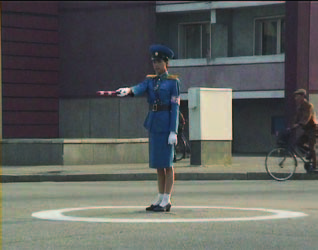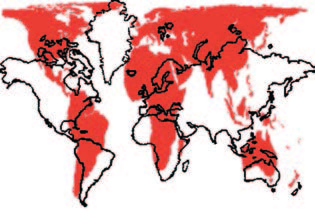More than a thousand years ago they had a powerful empire. Today, Tibetans are fighting to preserve their national identity. Will they share the fate of Native Americans and Aborigines?
A group of monks crouches over an intricate construction. Very carefully, grain by grain, they apply the colored sand. Little by little, the mysterious lines drawn on the black table turn into an astonishing composition of geometrical forms. Their colors bring to mind a meadow in bloom, but their patterns remind us rather of the test strips that appears on TV when the programs are over. This is one of the evocative scenes in the film “Tibet: Cry of the Snow Lion”.
The template made by the monks is called a Mandala. In Sanskrit, this means “circle.” An intrinsic element of this “circle” is the final
act of destruction, or dismantling. The monks sweep up the sand, symbolizing the impermanence of all existence. And that‘s the essential thing: the Mandala is not just simple a work of art; it is rather the symbolic representation of the Universe. But, above all, it is a central aspect of the Tibetan cultural heritage.
More than a thousand years ago, the Tibetans had a powerful empire which covered most of south and central Asia. Their indigenous
belief in Bon was the precursor to a shamanistic religion mixed with Buddhism adopted in the 7th century. The worldview and way of life that grew from this religion changed the Tibetans into one of the most fascinating cultures on Earth.
Today, this culture is in danger of extinction. Today, Tibetans have to fight to preserve their national identity. This is the consequence of the Chinese invasions on Tibet in 1949 – 1951. The second date marks the year of the Seventeen-Point Agreement, which the delegacy of the Tibetan government was forced to sign. Not only did it constitute the basis of China‘s formal annexation of Tibet, but it also served as a symbolic warning for the Tibetans: Here was the beginning of a one-sided struggle, and the Chinese would attempt to win by any means necessary.
The national uprising in Lhasa in 1959 gave the invaders an excuse to cancel the agreement and to crush the Tibetan fantasy of autonomy. Although there still exists an organization called the Tibetan Autonomous Region (TAR), which consists of half of the territories of ethnic Tibet, it is completely subordinated to the communist government of China and used only to suppress the Tibetans’ aspiration to self-determination.
Regardless of the words we choose to describe Tibet‘s political status – whether we say it‘s an autonomy, a Chinese colony, or an occupied territory – the facts are obvious. The policy implemented by China aims to reduce Tibetans from a separate nation to one of the insignificant ethnic minorities of their country.
China’s “Final Solution”
Nowadays in Tibet, even a hint of the national consciousness is forbidden. Possessing a picture of the Dalai Lama, singing patriotic songs, displaying Tibetan flags and even speaking with foreigners is penalized. Nonviolent demonstrations against Chinese rule are brutally punished. All of these are treated as illegal separatist activities and a menace to the mother country, China. Detention, unfair trials, and torture are just some of the many ways in which human rights in Tibet continue to be abused.
In 1992, when the monk Palden Gyatso escaped out of Tibet and into India after 33 years in prisons and labor camps, the world finally got to see about the atrocities suffered by the prisoners from the hands of the Chinese. Gyatso managed to smuggle out the instruments of his torture, including electric batons and cattle prods. People listened, at last.
But these are not the only methods being used by Chinese to get rid of the Tibetan nation. The government is implementing a policy of settling millions of Chinese civilians in the occupied territory. They already outnumber the Tibetan population of around 6 million. China‘s oppressive demographic policy extends to the rigorous birth-control measures imposed in Tibet, which involve forced abortion even in the eighth month of pregnancy and mandatory sterilization. Nonetheless, all the independent statistics do not discourage the Chinese government from stating cynically the following in its latest White Paper: “Another lie is the claim that a large number of Hans have migrated to Tibet, turning the ethnic Tibetans into a minority.”
The struggle with Chinese propaganda is another stage on which the Tibetans have to get along. Manipulation of the historical facts and ignoring the objective data seem to be the essential ways of communication in the communist countries. Even the Chinese government has acknowledged them as fact: Chinese government spokesman, Mr. Hu, said the following in reference to the question of human rights in China: “Some filmmakers have depicted the Dalai Lama as the standard bearer of human rights. The policy he pursued and defended in Tibet before 1959 is much darker and crueler than the Negro slavery system in the United States before the Civil War. Since 1959, China has made progress in all areas, including human rights, in Tibet.”
After all, the Chinese legitimization of their attack on Tibet in 1949 was based on the use of such manipulation. Their selective view of history has led them to the conclusion that the Central Chinese Government has been ruling in Tibet since the Yuan dynasty, which reigned in the 13th century. Therefore, we learn from the Chinese embassy website, Tibet has never been an independent country.
As for the Tibetans, they continue with their unique strategy. “Because violence can only breed more violence and suffering, our struggle must remain non-violent and free of hatred;” the Dalai Lama rejects the Chinese methods of fight. The occupants call him “a petty tribalist,” but he stands firm: “The Chinese have done horrible things to us; they continue to do these things even now. But I still hold no hatred in my heart for them.”
Native Americans, Aborigines…Tibetans?
As a result of this unfair fight, the Tibetans are alienated in their country and marginalized in all walks of life. Every year, about 3,000 of them risk their lives escaping to Dharamsala in India. People are torn between defending their mother culture and adopting the Chinese one, which could enable them at least to make a living. Perhaps these are some of the reasons for the dramatic rise of alcoholism and suicide among Tibetans in recent years.
There is no doubt that the Chinese policy of terror combined with the indolence of the international diplomacy has been leading to irreversible changes in the character of the Tibetan existence. We have become accustomed to all these campaigns for a “Free Tibet” and so on, but the phrase “Free Tibet” has by now become a cliché, an idea that does not matter in the world of great politics. For as long as an argument for human rights is welcome, so is the argument for Tibet. But the support runs dry as soon as the Privilege Clause is concerned. If this two-faced policy continues much longer, the fragile situation of the Tibetan nation will not get any better. Ultimately, the people of Tibet will share the fate of the sand Mandala, their culture‘s color and beauty swept away by a more powerful invader. It happened to the Native Americans, the Aborigines, and the Uighurs in the Chinese province of Xinjiang. No longer a nation, and not even a significant ethnic group, the Tibetans may, very soon, become nothing more but a tourist attraction in China.


















